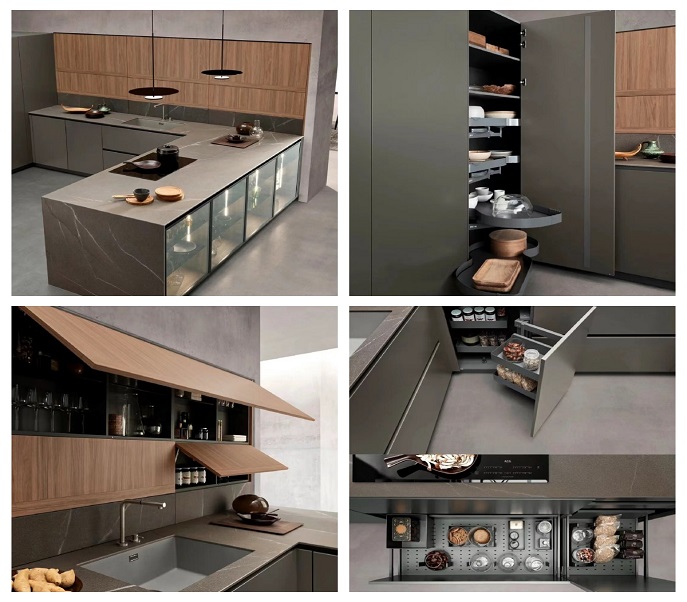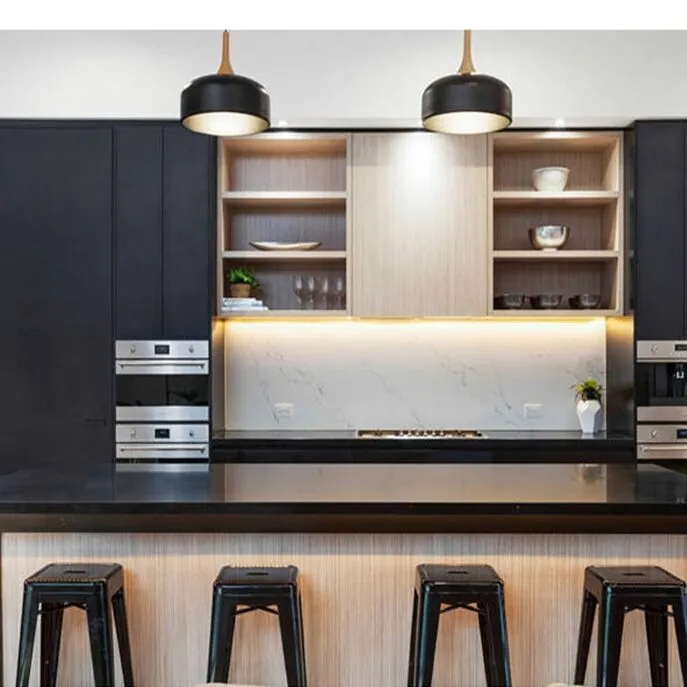Thinking of a Black Kitchen? What to Know Before You Commit
Why Black Kitchens Are Gaining Popularity
Introduction
Black kitchens are popping up everywhere in home design. Their striking, smooth style turns heads, making any kitchen a trendy focal point. From urban lofts to snug suburban houses, black cabinets add a cool twist that suits styles like industrial or simple minimalist. Homeowners adore how these dark setups stay classic yet flexible, blending with wood, metal, or stone for a one-of-a-kind look. This guide explores why black kitchens are hot, how to pull them off, and pitfalls to avoid, using real examples like high-gloss finishes and top-notch manufacturing standards.
The Allure of Black Kitchens
Black kitchens catch eyes fast. They’re more than just cabinets; they bring a strong, self-assured, modern feel. Imagine a matte black kitchen in a city apartment, standing out with its sharp lines and bold contrast against white quartz counters. This style feels fresh but works in older homes too. Black cabinets fit neat Scandinavian vibes or raw industrial spaces just as well.
Why are they so popular? People want kitchens that feel like them. Black delivers. It’s a blank slate for mixing textures, like wooden islands or brass knobs. And it’s classic. Unlike fleeting greens or blues, black stays stylish. A kitchen with black cabinetry, crafted with machine-driven precision for consistent quality, shines while handling daily wear. Plus, scratches blend in better than on lighter colors—a big plus for busy homes with kids or pets.

How Black Cabinets Bring Class
Nothing screams fancy like well-made black cabinets. They add a rich, deep vibe, making a kitchen feel polished. Glossy lacquer grabs light for a swanky look, while matte finishes keep it subtle but classy. Toss in gold or steel hardware, and the elegance soars. Picture a kitchen with brushed brass pulls on matte black cabinets—cosy yet upscale, ideal for a home cook who cares about style and function.
The way they’re made matters. Factories with high-tech setups, like those covering 3,500 square meters with German machines, produce cabinets with no gaps or flaws. This careful work keeps the look clean, with every door lining up perfectly. It’s not just good-looking—it’s tough, built to meet strict European and USA standards for lasting strength.
Things to Watch Before Going Black
Lighting Can Make or Break It
Black cabinets need light to pop. Without it, they can seem heavy or dull. Big windows are awesome, letting sunlight bounce off dark surfaces. In a kitchen without windows, under-cabinet LEDs or stylish pendants work great. A tiny galley kitchen with matte black cabinets and bright under-counter lights feels roomy, not tight. Good lighting doesn’t just help you see—it makes the cabinetry’s rich colors stand out, keeping the space warm and welcoming.

Room Size and Layout Matter
Black fits any kitchen, but the size changes how it feels. Big, open kitchens can rock all-black setups, looking daring without feeling heavy. Smaller spaces need a bit of care. Pair black cabinets with white walls or light wood floors to keep things open. Open shelves or glass-front doors lighten the dark bulk while still offering storage. A small kitchen with black lower cabinets, white uppers, and a marble countertop feels modern but spacious.
Keeping Them Clean
Black shows dust and smudges more than white. Kid fingerprints from grabbing snacks or grease from cooking pop right out. But it’s not a dealbreaker. A quick wipe with microfiber cloths and mild cleaners keeps things spotless. Edge-sealing tech, used in high-end cabinets, adds moisture protection, cutting down wear. Regular cleaning keeps a black kitchen sharp, even in a lively home where meals are always cooking.
Pairing Black Cabinets with Other Elements
Countertops and Backsplashes
Light countertops pair best with black cabinets. White marble or quartz bounces light, balancing the darkness. A kitchen with black cabinets and a creamy quartz counter feels bright yet solid. Backsplashes bring extra style—white subway tiles keep it simple, while metallic mosaics add a splash of glamour. Textured stone or patterned tiles give depth without clashing, pulling the whole design together.
Hardware and Fixtures
Knobs and handles let your personality shine. Brushed gold warms up matte black cabinets, creating a cozy but fancy feel. Stainless steel gives an industrial edge, great for city lofts. Matte black hardware blends in for a clean, simple look. Small details, like brass pulls on a glossy black island, make the kitchen feel custom without costing a fortune.
Walls and Flooring
Neutral walls, like soft grey or warm white, stop black cabinets from feeling too heavy. Oak or walnut wood floors add a cozy touch, grounding the space. Patterned tiles, like geometric shapes, bring texture without fighting the cabinets. Factories using computer-run panel production make sure flooring matches perfectly, creating a unified look that ties the room together.

Pros and Cons of Black Kitchen Cabinets
Why Go Dark?
Black cabinets come with big wins. They’re timeless, sidestepping the traps of trendy colors. They’re flexible, mixing with wood, stone, or metal for endless custom looks. Scratches or dings? They’re less obvious than on white. Plus, they feel special—distributors using high-quality black cabinetry see 30-50% business growth, showing their appeal in custom designs.
The Downsides
Black has flaws. Dust and smudges show up quickly, needing frequent wipes. Small kitchens can feel cramped without enough light or contrast. And if you’re selling your home, some buyers lean toward neutral tones over dark kitchens. But clever design—like adding light counters or open shelves—solves most of these problems.
Tips to Nail a Black Kitchen
Add Contrast with Shelving or Accents
Too much black can feel heavy, so mix it up. Open wood shelves or metal racks add a breezy feel. Show off white dishes or green plants for pops of color. A kitchen with black cabinets and oak shelves holding glassware feels homey, not stark. Bright stools or bold artwork add life without overpowering the space.
Mix Materials for Warmth
Pair matte black cabinets with warm wood islands or textured stone counters. This softens the vibe, making it welcoming. A kitchen with black cabinets, a walnut island, and a stone backsplash feels balanced, not cold. Top manufacturers provide samples—benchtop swatches, color charts, door styles—so you can see the mix before deciding.
Lean on Expert Support
Custom kitchens shine with help. Distributors get training, business plans, and 3D design support to create standout spaces. Factories offer showroom samples, from paint shades to panel types, so homeowners know exactly what they’ll get. After-sales help, like website builds or market visits, keeps the design perfect over time.
FAQ About Black Kitchen Cabinets
Q:Can you customize everything—cabinets, counters, styles?
A:Absolutely. Showroom samples include table tops, color charts, and door panels, letting you preview the exact look before building.
Q:Are custom black cabinets pricier?
A:They might cost more at first, but their strength and custom fit save money long-term. Quality edge-sealing keeps them moisture-proof and durable.
Q:How’s the quality ensured?
A:Automated German machinery and strict European/USA standards mean no gaps, consistent finishes, and cabinets built for tough use.
Q:What about after-sales help?
A:Plenty. Free 3D designs, market visits, and website support for distributors make sure your kitchen stays flawless after installation.

